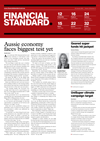Funding green buildings risks greenwashing accusationsBY ROSE MARY PETRASS | THURSDAY, 18 APR 2024 3:39PMClimate Energy Finance (CEF) says buildings are the "low-hanging fruit" that make up the lion's share of the big four banks' sustainable finance target (SFT) of $385 billion by 2030 - while just 7% flows to financing clean energy and hard-to-abate sectors. There is a green financing shortfall across key sectors including energy, transport and cleantech, the independent think tank says. Report author, CEF analyst Nishtha Aggarwal says the banks' current strategies rely on investing in "business-as-usual" real assets that "meet minimum energy efficiency regulations" - leaving the banks "open to accusation of greenwashing". Between 44% and 72% of climate-related capital allocations flows to buildings. "Buildings are only truly green once they are fully electrified and thermally efficient, the grid is producing zero-emissions electricity, and building materials are decarbonised," CEF director Tim Buckley said. "That requires concerted action and investment to build firmed utility-scale renewable energy and reduce emissions in hard-to-abate sectors like steel, cement, and aluminium." To date a total of $184 billion in combined fund flows have been moved into SFT's by Australia and New Zealand Banking Group (ANZ), National Australia Bank (NAB), Commonwealth Bank of Australia (CBA), and Westpac. CBA's target is $70 bn by 2030. It's current allocations to buildings are eight times the amount it invests in renewables, at 72% and 9% respectively. NAB's property allocation comprises almost 50% of its $70 bn target and the think tank says the bank lacks transparency as total allocations to renewables, transport, or hard-to-abate sectors was unable to be ascertained. Westpac's $55 bn by 2030 target has the highest proportion of financing to clean energy (35%) and transport (8%), with 48% to buildings. However, it's new Sustainable Finance Framework sets a higher than regulatory-grade benchmark for green residential building criteria. The framework will be replaced by the national sustainable finance taxonomy once finalised at the end of 2024. A Westpac spokesperson commented: "The Australian Sustainable Finance Taxonomy is a critical piece of work to align industry reporting. Westpac is supporting the ASFI-led program of work. Westpac has also released its own Group Taxonomy to give our investors and shareholders transparency on our lending approach through until a national taxonomy is implemented." ANZ has committed the largest sum at $150 bn in sustainable financing this decade, with 7% to clean energy and 11% to buildings. ANZ has a combined 64% allocation towards tools such as sustainability-linked and facilitative finance. It is the only big four bank reportedly without a substantive policy to restrict financing to new oil and gas, CEF says. "Banks need to actively reorient their lending if they are to align their climate rhetoric with their capital flows," Aggarwal, said. "Australia's sustainable finance taxonomy, due for release by the end of this year, while designed to provide more consistent definitions across asset classes captured within the banks' SFTs, is unlikely to turn this bleak picture around at the speed and scale the climate science demands. The banks should "advocate for more ambitious and coordinated policy, regulatory and investment settings that reflect and enable our national climate and sustainable economic growth goals." The big four banks are "key drivers" of the capital mobilisation needed to ensure Australia achieves its targets and remains competitive in a decarbonised world economy, CEF director Tim Buckley said. The banks "must expand" their financing of energy infrastructure and value-added critical minerals, he added. "This goes hand-in-hand with the imperative to commit to enabling a science aligned progressive fossil fuel phase-out across their financed emissions exposures." FS Sustainability reached out to the banks, but they did not comment at the time of publishing. Related News |

Today, senior journalist and host Rose Mary Petrass sits down with Sharon Davis, Executive Director of Investments at Future Super, a superfund that invests for a fossil fuel free future.
With effective risk management and capital allocation, Australia's carbon market can scale to become the biggest in the world, Westpac and the Carbon Market Institute (CMI) say.
Board directors of energy companies continue to be elected with over 95% shareholder support, even when those companies perform poorly against investor expectations.
The RIAA Conference Australia 2024 is coming up in May, helping investors navigate the mainstreaming of sustainability, and unveiling pivotal initiatives like the Sustainability Classifications and the Artificial Intelligence and Human Rights Investor Toolkit.















